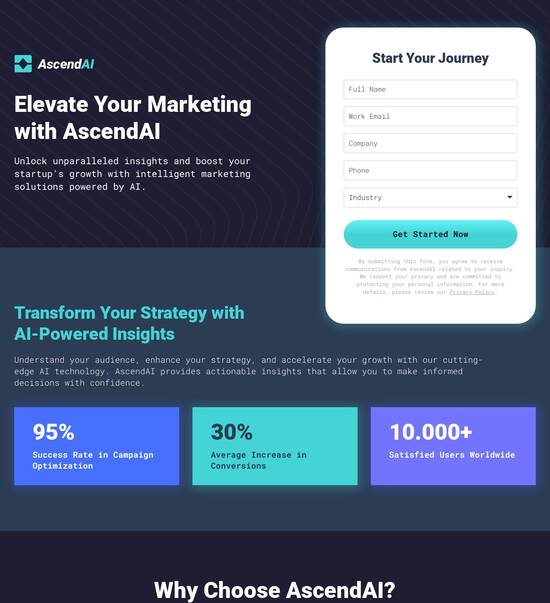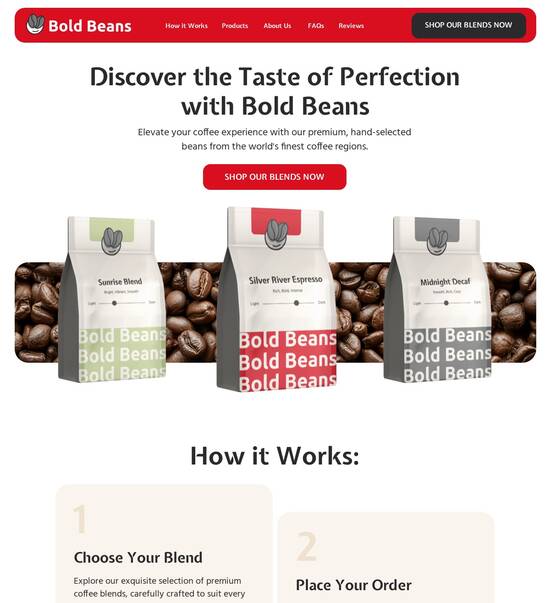
Next.js optimized sales page templates
Explore Similar TemplatesAbout template
Make the most with Next.js optimized sales page templates. Drive your success today.
Recommended templates

Easy to build without coding
With the intuitive drag-and-drop builder, anyone on your team can create high-converting pages without any knowledge of code or design. Make enhancements to your landing page with custom widgets using Javascript, HTML/CSS, or third-party scripts.

Multiple layouts for any industry and goal
Select from 500+ landing page layouts built to boost conversions across industry-specific scenarios. Customize them by adjusting fonts, adding images, and generating on-brand content with the AI assistant. Quickly scale with Instablocks® and Global Blocks that you can save, reuse, and update globally.

Loads fast and looks polished on any device
Every template is responsive, which means they present professionally on any device and load blazingly fast with our Thor Render Engine. You can also power them up with Google AMP technology to deliver an unparalleled mobile experience and drive higher conversions.

Robust analytics & experimentation
Get real-time updates and reporting across all your devices, showing the number of visitors, conversions, cost-per-visitor, and cost-per-lead. Launch AI-powered experiments, run A/B tests, and use heatmaps to analyze user behavior, then optimize your landing page to maximize conversions.







Easy to build without coding
With the intuitive drag-and-drop builder, anyone on your team can create high-converting pages without any knowledge of code or design. Make enhancements to your landing page with custom widgets using Javascript, HTML/CSS, or third-party scripts.
Multiple layouts for any industry and goal
Select from 500+ landing page layouts built to boost conversions across industry-specific scenarios. Customize them by adjusting fonts, adding images, and generating on-brand content with the AI assistant. Quickly scale with Instablocks® and Global Blocks that you can save, reuse, and update globally.
Loads fast and looks polished on any device
Every template is responsive, which means they present professionally on any device and load blazingly fast with our Thor Render Engine.
Robust analytics & experimentation
Get real-time updates and reporting across all your devices, showing the number of visitors, conversions, cost-per-visitor, and cost-per-lead. Launch AI-powered experiments, run A/B tests, and use heatmaps to analyze user behavior, then optimize your landing page to maximize conversions.
All the features you need to build lead-generating landing pages
Explore more featuresLearn how to build top-performing landing pages for any goal
FAQs
Leading the way in building high-performing landing pages





Optimize your marketing with the Instapage landing page and CRO platform
Instapage is designed to elevate your marketing campaigns through a versatile landing page and conversion rate optimization (CRO) platform. With unique features and a user-friendly interface, Instapage empowers marketers to implement effective, high-converting strategies, ensuring optimal return on investment (ROI). Accessing more than 100 professionally designed templates, you can effectively cater to your audience’s needs.
Understanding the significance of landing pages
Landing pages are crafted to drive specific actions from users, such as signing up or making a purchase. By utilizing Instapage, marketers can harness targeted features that enhance user experience and conversion rates. Landing pages are crucial for segmenting your audience and tailoring offerings.
- Tailored Design: Create engaging layouts that resonate with your specific audiences, enhancing the likelihood of conversions.
- Focus on Conversions: Craft pages specifically designed for lead generation, reducing distractions and improving visitor journey.
- Analytics and Optimization: Utilize integrated analytic tools to assess your landing page performance and optimize based on data-driven insights.
Steps to create your first landing page
Creating a landing page with Instapage is straightforward and efficient. Here’s how to get started:
- Choose a Template: Select from over 100 professionally designed templates tailored for various industries.
- Customize Your Page: Use the intuitive drag-and-drop builder to add elements such as images, videos, and forms without any coding knowledge.
- Set Up A/B Testing: Enable A/B tests to compare different versions of your landing page, ensuring that you know which variants perform best with your audience.
Optimizing for conversions
Optimization is a key aspect of using the Instapage platform. Achieving higher conversion rates requires continuous refinement based on performance insights.
- Utilize Heatmaps: Gain insights into user behavior, allowing you to pinpoint areas on the page that can be improved for better user interaction.
- Dynamic Text Replacement: Use dynamic text that aligns with search queries to enhance relevance and drive more conversions.
- Integration with Advertising: Integrate your ads with specific landing pages for better alignment between advertising efforts and landing page content.
Incorporating these elements ensures a more productive use of your marketing budget and drives better outcomes.
The combination of user-friendly design and powerful optimization tools makes Instapage a must-have for any marketing team aiming to boost their digital campaigns.
Start leveraging the power of Instapage for your landing pages today! We'll help you maximize your marketing impact and accelerate your conversion rates.
People also ask about Next.js optimized sales page template
Crafting the ultimate Next.js optimized sales page template: A comprehensive exploration
The evolution of landing pages in the digital landscape
Landing pages have transformed significantly since their early days when they served primarily as simple one-page sales pitches. Initially designed to attract clicks from ads, their purpose has evolved into a more intricate role in online marketing strategies. Today, landing pages are critical touchpoints where brands can engage potential customers, convey value propositions, and prompt specific actions. As a result, they must be thoughtfully designed and optimized. This shift aligns perfectly with the growing complexity of consumer behavior in our online environment.
The arrival of Next.js has reshaped how developers conceive and implement these crucial pages. This React-based framework enables powerful features such as server-side rendering and static site generation, which profoundly impact site performance and SEO. With ever-increasing competition in digital marketing, Next.js has become more than just another framework; it’s a game changer for building high-converting sales pages.
Historical evolution from simple pages to complex marketing tools
The rise of Next.js and its relevance in modern web development
Current trends highlighting optimization and user experience
Why Next.js is a game-changer for sales pages
Next.js offers a unique architecture that leverages React’s component-based structure while enhancing it with features best suited for sales pages. One of the standout benefits is its support for server-side rendering (SSR) and static site generation (SSG). This means content can be pre-rendered at build time or dynamically generated per user request, ensuring that users receive the fastest possible experience. Fast-loading pages not only enhance user satisfaction but also significantly boost conversion rates.
Another commendable aspect of Next.js is its built-in performance optimizations. Automatic code splitting ensures that only the necessary JavaScript for the current page is loaded, reducing loading times further. Features like image optimization also come standard with Next.js, guaranteeing a seamless viewing experience that can influence a visitor's decision to engage or convert, solidifying its status as the go-to solution for sales pages.
Key features of Next.js optimized sales page templates
Building a sales page using Next.js opens the door to a wealth of features that enhance user experience and boost conversions. Dynamic content handling is first among these features. By leveraging API routes, developers can fetch real-time data effortlessly, giving users the most relevant information tailored to their needs. Moreover, pre-rendered pages improve on-page SEO, helping the page to rank higher in search results, which can drive organic traffic to the site.
Image optimization is another key attribute of Next.js. Using the built-in Next.js Image Component, developers can ensure images are loaded quickly without sacrificing quality. Strategies like lazy loading images that are out of view can also contribute to a faster initial load time, creating a better first impression for visitors. Lastly, automatic code splitting improves performance by minimizing the size of JavaScript bundles sent to the user’s browser, allowing for quicker interactions.
Dynamic content handling through API routes
Pre-rendering for better SEO
Image optimization via the Next.js Image Component
Automatic code splitting for enhanced performance
Tailwind CSS and Next.js: A perfect combination for design
When it comes to designing sales pages that not only look professional but also perform well, Tailwind CSS emerges as an outstanding companion for Next.js. Tailwind’s utility-first design philosophy allows developers to create aesthetically pleasing layouts without compromising on functionality. Each Tailwind class to be applied directly in the markup enables rapid prototyping and makes adjustments simple, which is invaluable in a fast-paced marketing environment.
The flexibility offered by Tailwind enhances the responsiveness of sales page templates, ensuring that they look great across various devices. This adaptability is crucial because a significant portion of web traffic comes from mobile devices today. Integrating Tailwind CSS with Next.js is straightforward, and those curious about performance can benefit from specific setups to ensure minimal bloat while maintaining effectiveness in creating visually engaging interfaces.
Creating a compelling user experience with Next.js
Creating a sales page that converts effectively goes beyond merely aesthetic considerations; it requires a deep understanding of user experience design principles. An effective layout is critical, guiding users naturally toward the desired action. Leveraging components and reusable templates makes it easy to maintain a cohesive look and feel, which can help elevate brand identity and ensure users feel at home while navigating.
In addition to visual design, crafting engaging content is paramount to turning visitors into customers. This means focusing on clear, actionable messaging alongside compelling visuals to bolster engagement. Highlighting customer testimonials, clear calls to action, and well-placed selling points in an organized manner can help keep users interested and encourage them to finalize a purchase. Combining these elements effectively can lead to higher conversion rates, linking design and usability tightly together.
Integrating content management systems (CMS) with Next.js templates
Integrating a content management system with Next.js can streamline the process of managing website content, making updates easier and more efficient. Popular options like Strapi, WordPress, and Contentful are highly compatible with Next.js and offer unique strengths. Strapi provides a user-friendly interface for content creators, while Contentful excels in scalability. This integration allows developers to focus on building engaging templates while enabling marketers to make changes without needing ongoing technical support.
Connecting a CMS to a Next.js sales page typically involves setting up API calls to fetch and deliver content dynamically. This headless CMS approach allows teams to build flexible, scalable websites that adapt to changing marketing needs. Furthermore, it empowers marketers by facilitating immediate adjustments to content, layouts, or promotional campaigns—an essential factor in today’s rapidly changing marketing landscape.
Customization and flexibility: The power of Next.js templates
Customization is vital in creating an optimized sales page that addresses specific business needs. Next.js empowers developers to modify templates extensively based on individual project requirements, ensuring a more customized solution. The use of custom hooks and reusable components allows teams to add advanced functionality, scaling the breadth of interactivity available to users without compromising site speed or performance.
For instance, developers might create interactive product galleries or advanced forms tailored to user needs. Additionally, existing synergies in the Next.js ecosystem provide resources for creating and adapting templates that fit unique branding or functionality requirements perfectly. Staying responsive to a project’s evolving demands is essential for long-term success.
Improving templates based on project-specific needs
Developing custom hooks for added functionality
Using reusable components for efficiency
Launching your Next.js sales page: Best practices and tips
Once the Next.js sales page is ready and optimized, ensuring its successful launch is the next crucial step. Testing and optimization are fundamental practices to consider. Using tools like Lighthouse or GTmetrix can help measure performance metrics and identify areas inline for enhancement. Fine-tuning elements like payload size or image compression will significantly improve load times and, in turn, user experience, which is key for effective conversions.
Additionally, following SEO best practices tailored for Next.js deployments can ensure optimal visibility in search engines, which is essential for driving traffic. This includes focusing on clean URLs, structured data, and proper metadata. Finally, employing effective marketing strategies, such as leveraging social media, content marketing, and email campaigns, can help generate interest and traffic toward the new page.
Future trends in landing page development with Next.js
Looking ahead, it is likely that Next.js will continue to evolve, bringing new functionalities and capabilities that enhance the development process. The integration of artificial intelligence and machine learning can revolutionize how landing pages are personalized and optimized based on user behavior. As these technologies advance, they could help marketers create even more targeted experiences that drive higher conversion rates through strategic data use.
Furthermore, the development of JAMstack is forging a path toward more decoupled architectures that facilitate better performance and security. This shift will enable greater flexibility in managing the hosting, database, and server functions, reshaping how sales pages are built and maintained. The fusion of Next.js with these emerging technologies may lead to a new paradigm in landing page design and implementation, elevating user experience standards.
Case studies: Successful implementations of Next.js sales page templates
Exploring real-world projects that have successfully utilized Next.js for sales pages provides invaluable insight into the framework's effectiveness. For instance, one tech company reported a 30% increase in conversion rates after transitioning their sales page to a Next.js architecture. Features such as automated page pre-rendering and efficient data fetching played a significant role in achieving these results, alongside a fresh new design incorporating Tailwind CSS.
Another example comes from a financial services firm that implemented a Next.js sales page optimized for speed and SEO. By focusing on instant loading times and seamless interactions, they greatly improved user engagement, which reflected positively on their overall performance metrics. These insights aren’t just anecdotal; they offer clear evidence of how adapting to Next.js can lead to notable improvements in audience engagement and conversion efficacy.
Building a community of developers around Next.js and landing page design
Creating a thriving community of Next.js developers can act as a powerful resource for sharing knowledge and advancing the framework. Online forums, local meetups, and events offer spaces for developers to explore best practices, resolve challenges, and collaborate on open-source projects. Home to discussions on performance optimizations, reusable components, and integrations with all types of CMS, these communities can serve as a launch pad for innovative ideas.
The collaborative spirit within the Next.js community fosters a shared desire for improvement and excellence. Developers can learn from their peers’ experiences, gathering insights that can help refine their landing page strategies. In this interconnected ecosystem, Next.js has evolved not merely as a development tool but as a framework enriched by contributions and shared successes.
Ready to skyrocket conversions?
Supercharge your ad campaigns with high-performing landing pages
Get started














